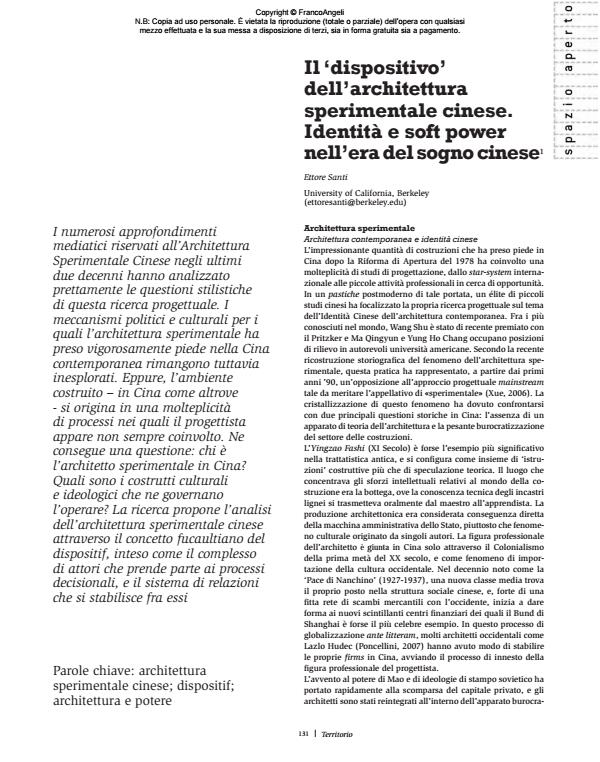Il ‘dispositivo’ dell’architettura sperimentale cinese. Identità e soft power nell’era del sogno cinese
Journal title TERRITORIO
Author/s Ettore Santi
Publishing Year 2016 Issue 2016/76
Language Italian Pages 10 P. 131-140 File size 418 KB
DOI 10.3280/TR2016-076018
DOI is like a bar code for intellectual property: to have more infomation
click here
Below, you can see the article first page
If you want to buy this article in PDF format, you can do it, following the instructions to buy download credits

FrancoAngeli is member of Publishers International Linking Association, Inc (PILA), a not-for-profit association which run the CrossRef service enabling links to and from online scholarly content.
I numerosi approfondimenti mediatici riservati all’Architettura Sperimentale Cinese negli ultimi due decenni hanno analizzato prettamente le questioni stilistiche di questa ricerca progettuale. I meccanismi politici e culturali per i quali l’architettura sperimentale ha preso vigorosamente piede nella Cina contemporanea rimangono tuttavia inesplorati. Eppure, l’ambiente costruito - in Cina come altrove - si origina in una molteplicità di processi nei quali il progettista appare non sempre coinvolto. Ne consegue una questione: chi è l’architetto sperimentale in Cina? Quali sono i costrutti culturali e ideologici che ne governano l’operare? La ricerca propone l’analisi dell’architettura sperimentale cinese attraverso il concetto fucaultiano del dispositif, inteso come il complesso di attori che prende parte ai processi decisionali, e il sistema di relazioni che si stabilisce fra essi
Keywords: Architettura sperimentale cinese; dispositif; architettura e potere
- School of Architecture(s) - New Frontiers of Architectural Education Marco Trisciuoglio, Bao Li, pp.375 (ISBN:978-3-031-71958-5)
Ettore Santi, Il ‘dispositivo’ dell’architettura sperimentale cinese. Identità e soft power nell’era del sogno cinese in "TERRITORIO" 76/2016, pp 131-140, DOI: 10.3280/TR2016-076018